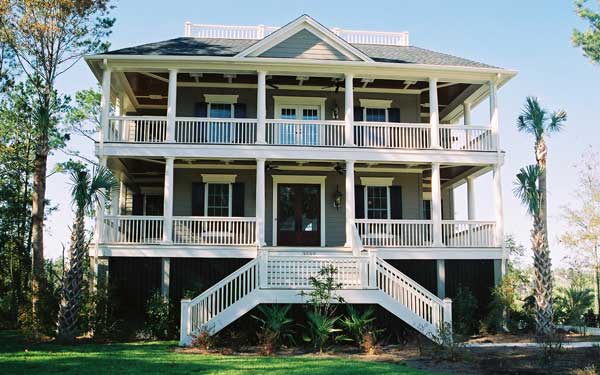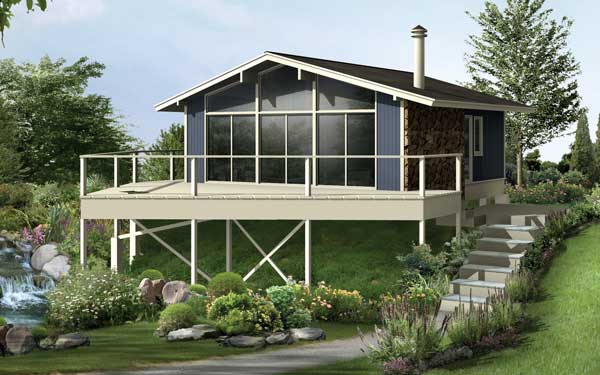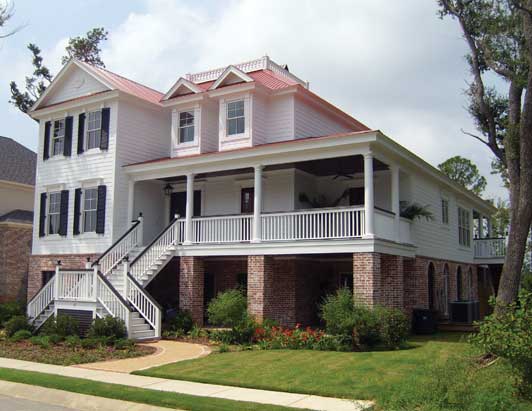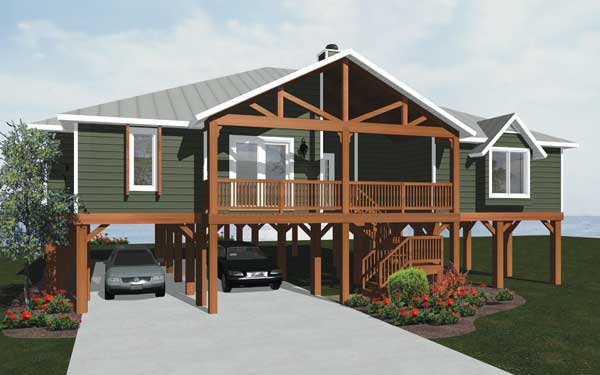 by Jennifer Jones
by Jennifer Jones
When building a new home, one of the most important decisions is choosing the best foundation type for your land site. There are many different foundation bases that fit certain types of homes more efficiently. If the conditions are right for your new home and lot, a pier foundation might be the safest and most efficient choice for you. Pier foundations can be built in a variety of construction materials and are less costly when it comes to installation and labor expenses. Additionally, issues with a pier foundation are more infrequent than with other foundations and are less costly to fix. For specific information on whether a pier foundation will work for you, it is a good idea to contact a local contractor who can answer questions about constructing the design. Homeowners insurance coverage, the depth of the footings and the popularity of piers in the area will also help determine if a pier foundation is a good fit for your new home.

See Plan #024S-0011 above
View Other Homes with Pier Foundations
What is a pier foundation?
A pier foundation is very similar to how a deck is supported over a body of water. Unlike solid slab foundations, the space beneath the home is entirely open with the exception of various columns. Also known as stilts, these piers support a home several feet above the ground on a number of individual columns. They are secured to the surface through concrete footings with the capacity to hold the weight and size of home. This creates a crawl space beneath the home that allows plenty of natural ventilation. Many pier foundation homeowners will hide this empty space with exterior walls and/or utilize it as a carport or garage area.

See Plan #008D-0133 above
Locational Benefits
Since the home is elevated on the piers, this type of foundation allows for construction on problematic sites. They are most popular along the coastlines, wetlands and other large bodies of water where flooding can be an issue. Not only are pier foundations economically built to avoid water, but they also offer a raised, scenic view for the homeowner. Louisiana is the most common state that utilizes the benefits of pier foundations, since it is composed largely of wetlands and coastal areas. Additionally, a pier foundation can be advantageous for areas with an exposed ledge or a challenging slope. However, piers can become unstable from strong vibrations, so avoid building in high-risk earthquake zones.
Soil grades also play a factor with pier foundations. They are excellent for locations with unusual soils, such as sand. Green homebuilders love using pier foundations because they leave a smaller footprint on the earth beneath the building. They also disturb the soil and tree roots very little compared to other foundation types. This lack of excavation makes the pier foundation one of the most economical foundations to build.

See Plan #024S-0022 to the left
Construction
Also known as pier and beam homes, houses with pier foundations are constructed from reinforced concrete blocks and brick masonry. The footings are formed in a controlled environment, so no need to worry about the weather creating challenges when curing the concrete. The reinforced concrete serves as pad footings for the pier supports. These columns are known as posts when they are installed with the largest end at the ground. Installations with the smallest end close to the ground are referred to as pilings. This type of home support is unlike other conventional concrete footings and wall bearings, since it supports the home at a set number of individual points instead of continuous wall support. The average spacing of columns is generally between eight and twelve feet. A simple pier foundation can be as easy as concrete filled cardboard tubes that are placed into hand-dug holes. For larger homes that need a more sturdy foundation, a complex pier foundation that incorporates helical screws and very deep piers is perfect for supporting larger loads.

See Plan #069D-0116 above
One important consideration when building a home with a pier foundation is proper floor insulation. Since the underneath of the home is open, the bottom of the floor is prone to the elements. Carefully insulating and sealing the floor with help prevent the weather, insects and moisture from damaging your home. Although the open space below makes routing and repairing utilities to the home a much easier task, the plumbing and sewer lines will require frost protection materials to keep them from becoming permanently damaged. In addition, termite detection can be discovered earlier with pier homes, since they must tunnel along the concrete footings before reaching any wood.

See Plan #024D-0241 to the right
There are many advantages with building a home on a pier foundation. Difficult lots with drastic slopes can be utilized by building a pier and beam home. They are perfect for coastal and swampy areas by providing useful protection from flooding. Construction and installation costs are less expensive than other foundations. You also have a wider variety of choice materials. And, last but not least, you can get the best view from a home raised on piers!
Here are some related articles:
Save this article to:
back to top